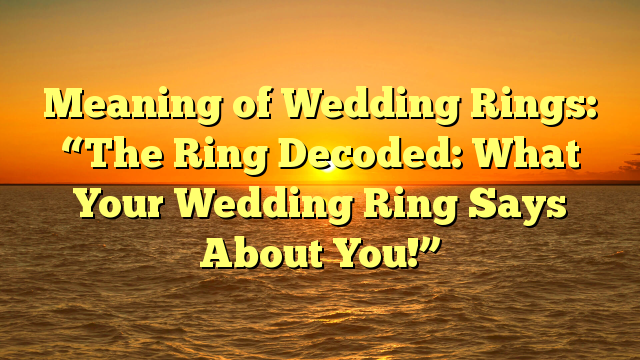“The Symbolic Significance of Wedding Rings: Unveiling the Hidden Messages”
Wedding rings hold a deep symbolic significance that goes beyond their physical form. These small bands of metal represent the eternal bond and commitment between two individuals. They serve as a constant reminder of love, trust, and unity in marriage. The circular shape of wedding rings symbolizes eternity, with no beginning or end, reflecting the everlasting nature of true love.
Furthermore, the exchange of wedding rings during a ceremony is not just a tradition but also an expression of commitment. It signifies the couple’s willingness to embark on this lifelong journey together, facing both joys and challenges side by side. The act itself holds immense emotional value for both partners as they publicly declare their devotion and fidelity to one another.
Moreover, wedding rings have evolved over time to reflect personal style preferences while still carrying significant meaning. From traditional plain gold bands to contemporary designs adorned with diamonds or other gemstones, couples now have countless options to choose from when selecting their wedding ring styles. This customization allows them to showcase their unique personalities while upholding the timeless symbolism behind these precious pieces.
The hidden messages within wedding rings are powerful reminders of love’s endurance and strength throughout history and across cultures worldwide. As we continue our exploration into this topic, let us delve deeper into various cultural perspectives surrounding the symbolism attached to these cherished symbols of matrimony.
“Expressing Commitment: How Your Wedding Ring Reflects Your Relationship”
Your wedding ring is a powerful symbol of the commitment you have made to your partner. It serves as a constant reminder of the love and dedication that exists within your relationship. The significance of this small piece of jewelry lies not only in its physical presence but also in the deeper meaning it holds.
The design and style of your wedding ring can reflect aspects of your relationship. For example, traditional rings often feature classic designs that symbolize timeless love and devotion. On the other hand, contemporary rings may incorporate unique elements or unconventional materials, representing a more modern approach to commitment.
In addition to design choices, the choice of metal for your wedding ring can also convey messages about your relationship. For instance, platinum is known for its durability and strength, making it an excellent choice for couples who value resilience in their partnership. Similarly, gold has long been associated with wealth and prosperity, suggesting a desire for abundance and success within the marriage.
By carefully considering these various factors when choosing your wedding ring, you are able to express not only personal style but also communicate important aspects about your relationship without saying a word. Your chosen ring becomes an outward expression of inner emotions – a testament to the depth of love shared between you and your partner.
“Traditional vs. Contemporary: Exploring Different Styles of Wedding Rings”
When it comes to wedding rings, there is a wide range of styles available, each with its own unique characteristics. Traditional wedding rings often feature a simple and timeless design, typically made of gold or silver. These classic styles symbolize everlasting love and commitment, representing the traditional values that have been passed down through generations. On the other hand, contemporary wedding rings embrace modern trends and individuality. They may incorporate unconventional materials such as titanium or tungsten, and showcase intricate designs that reflect the wearer’s personal style.
Traditional wedding rings are known for their understated elegance. They usually consist of a plain band without any embellishments or gemstones. The focus is on the simplicity of the design and the symbolism behind it. Traditionalists appreciate these traditional styles because they embody tradition and heritage while maintaining a sense of timelessness.
In contrast, contemporary wedding rings offer endless possibilities for customization and self-expression. From bold geometric patterns to nature-inspired motifs, contemporary designs push boundaries in terms of creativity and innovation. With an emphasis on individuality, couples can choose from an array of metals like rose gold or platinum as well as incorporate diamonds or other precious stones into their ring design.
Whether you prefer a traditional or contemporary style for your wedding ring ultimately depends on your personal taste and preferences. While some may be drawn to the sentimental value associated with traditional designs, others may opt for something more unique that reflects their personality and relationship dynamics. The beauty lies in having options that allow couples to find a perfect representation of their love story through their chosen style of wedding ring.
“Unveiling Cultural Perspectives: The Symbolism of Wedding Rings Across the World”
Wedding rings hold immense cultural significance across the world, symbolizing love and commitment in various ways. In many Western cultures, the wedding ring is traditionally worn on the fourth finger of the left hand because it was believed that a vein directly connected this finger to the heart. However, customs differ greatly among different countries and regions.
For example, in India, wedding rings are not as common as other forms of jewelry like bangles or necklaces. Instead, couples often exchange garlands during their wedding ceremony to signify their union. In some African cultures, elaborate headpieces or necklaces may be exchanged instead of rings. These cultural variations highlight how symbolism can transcend traditional notions of what a wedding ring should be.
In Japan, simplicity and minimalism take center stage when it comes to wedding rings. Traditional Japanese weddings typically involve exchanging simple bands made from materials like gold or silver. This reflects the value placed on understated elegance and harmony within relationships. The focus is more on the act of exchanging rings rather than intricate designs or precious gemstones.
The symbolic meaning behind wedding rings varies significantly across different cultures worldwide. From ancient traditions rooted in folklore to modern interpretations influenced by changing societal norms, these diverse perspectives shed light on how love and commitment are expressed through this universal symbol of marriage.
“Beyond the Band: Intriguing Gemstones and Their Meanings in Wedding Rings”
Gemstones have long been associated with various meanings and symbolism, making them a popular choice for wedding rings. Each gemstone carries its own unique significance, adding depth and personalization to the ring. For instance, diamonds are often chosen for their timeless beauty and representation of everlasting love. They symbolize strength, purity, and clarity in a relationship.
Sapphires are another popular gemstone used in wedding rings. Known for their deep blue hue, they are believed to bring wisdom, loyalty, and truthfulness to the wearer’s marriage. This makes sapphire rings an ideal choice for couples who value honesty and trust as foundations of their relationship.
Emeralds offer a vibrant green color that represents hope, renewal, and fertility. These gemstones can be seen as a celebration of growth within a marriage or the start of a new chapter together. The lush green shade is also associated with prosperity and abundance – qualities that many couples aspire to cultivate throughout their lives.
By incorporating these intriguing gemstones into wedding rings, couples can infuse additional meaning into this already significant piece of jewelry. Whether it’s through diamonds’ representation of eternal love or emeralds’ symbolization of growth and fertility, each stone brings its own unique energy that resonates with different individuals on their journey towards marital bliss.
“Personality on Display: Decoding the Metal Choices for Wedding Rings”
When it comes to choosing a wedding ring, the metal choice can say a lot about your personality. Each type of metal has its own unique characteristics and symbolism that can reflect different aspects of your relationship. For those who prefer a classic and timeless look, traditional metals like gold or platinum are popular choices. These metals exude elegance and sophistication, making them perfect for couples who appreciate tradition and value longevity in their marriage.
On the other hand, if you’re looking to make a bold statement with your wedding ring, alternative metals like titanium or tungsten may be more fitting. These modern options offer durability and strength while also showcasing individuality and uniqueness. Couples who opt for these unconventional metals often have adventurous spirits and aren’t afraid to stand out from the crowd.
For those seeking something in between classic and contemporary, white gold or rose gold can provide the perfect balance. White gold offers a sleek yet understated appearance that complements any style, while rose gold adds warmth and romance to the mix. Choosing one of these metals shows an appreciation for both tradition and modern trends, indicating a couple’s ability to blend old-fashioned values with modern sensibilities.
In summary (without using “in summary”), by carefully selecting the metal for your wedding ring, you are not only choosing an aesthetic element but also expressing elements of your personality as well as what you value in your relationship. Whether you go for timeless classics like gold or platinum, daring alternatives such as titanium or tungsten, or opt for something in between like white gold or rose gold – each choice tells its own story about you as individuals coming together in love and commitment.
“From Classic to Unique: Understanding the Designs of Wedding Rings”
Wedding rings have long been a symbol of love and commitment, but the designs have evolved over time. Classic wedding ring designs typically feature a simple band made of gold or silver. These timeless styles are still popular today, as they represent tradition and elegance. However, modern couples are increasingly opting for unique designs that reflect their individuality.
Contemporary wedding ring designs offer a wide range of options to choose from. Some couples prefer intricate patterns or engravings on their bands, adding a touch of personalization to their rings. Others opt for non-traditional materials such as titanium or tungsten, which provide durability and a sleek aesthetic. Additionally, some couples choose to incorporate gemstones into their wedding rings for added color and symbolism.
The shift towards unique wedding ring designs is not only driven by personal preferences but also reflects changing societal norms. Couples are no longer bound by traditional expectations when it comes to their choice of wedding rings. They now have the freedom to express themselves through innovative and unconventional designs that truly capture their personalities and relationship dynamics without compromising on the significance behind this timeless symbol of love and commitment
“The Power of Engravings: Sentiments and Messages in Wedding Rings”
Engravings on wedding rings hold a profound emotional significance, as they allow couples to express their love and commitment in a deeply personal way. These inscriptions can range from simple initials and dates to heartfelt messages or quotes that encapsulate the couple’s bond. By engraving their rings, couples are able to create lasting reminders of their love story that will be cherished for years to come.
The sentiments and messages engraved on wedding rings serve as constant reminders of the promises made between partners. Whether it is a short phrase that holds special meaning or lyrics from a meaningful song, these engravings act as silent declarations of love and devotion. They provide an intimate connection between the couple and their ring, serving as a source of comfort during both joyous and challenging times.
Furthermore, engravings on wedding rings can also be seen as heirlooms passed down through generations. As time goes by, these engraved messages become treasured family mementos that carry with them not only the history of the couple who first exchanged vows but also the stories of those who came before them. The power of engravings lies in their ability to transcend time and leave an indelible mark on future generations, symbolizing enduring love across lifetimes.
“Unraveling the Origins: Tracing the History of Wedding Rings”
Wedding rings have a rich history that dates back thousands of years. The origins of this tradition can be traced to ancient Egypt, where the circular shape of the ring symbolized eternity and everlasting love. These early wedding rings were typically made from braided reeds or rushes, which were readily available materials at the time.
As time went on, different cultures began to adopt their own variations of wedding rings. In ancient Rome, for example, it was common for brides to receive two rings – one made of iron to be worn at home and one made of gold to be worn in public. This practice symbolized the transition from a woman’s role as a daughter to her new role as a wife.
In medieval Europe, wedding rings took on additional symbolism with the introduction of gemstones and engravings. Rings adorned with precious stones like diamonds or rubies became popular among royalty and nobility, while engraved messages added personal meaning and sentimentality. These intricate designs reflected not only an individual’s wealth but also their commitment and devotion to their spouse.
“The Evolution of Symbolism: How Wedding Ring Meanings Have Changed Over Time”
Throughout history, wedding rings have held various meanings and symbolisms that have evolved over time. In ancient civilizations such as Egypt and Rome, the circular shape of the ring was believed to represent eternity and everlasting love. It wasn’t until later centuries that the tradition of wearing a ring on the fourth finger of the left hand became popularized due to a belief in a vein that connected directly to the heart.
As societies progressed and cultures intertwined, different materials began to be used for wedding rings, further altering their symbolic significance. For example, in medieval Europe, gold bands adorned with intricate engravings were seen as a status symbol representing wealth and social standing. However, during times of war or economic hardship, simpler bands made from less valuable metals like iron or silver were often substituted.
In recent years, there has been a shift towards personalized wedding rings that reflect individuality rather than conforming to traditional symbolism. Couples are increasingly opting for unique designs incorporating gemstones with personal meanings or engraving special messages inside the band. This departure from convention highlights how wedding ring meanings have transformed from societal expectations into personal expressions of love and commitment.



